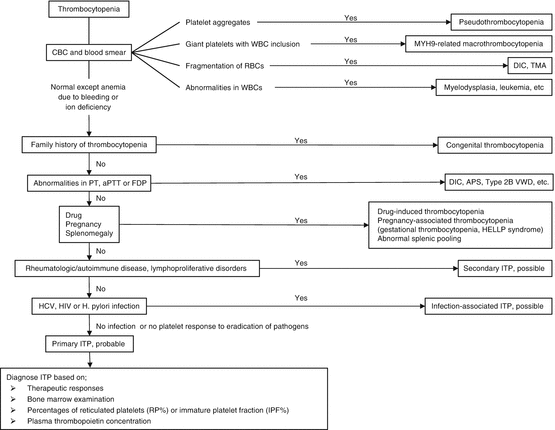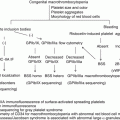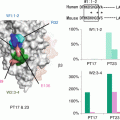Artificial thrombocytopenia
Platelet aggregation caused by insufficient anticoagulation
Platelet aggregation caused by EDTA-dependent immunoglobulin (pseudothrombocytopenia)
Giant platelets
Decreased platelet production
Congenital thrombocytopenia
MYH9-related macrothrombocytopenia
Wiskott-Aldrich syndrome
Congenital amegakaryocytic thrombocytopenia (CAMT), etc.
Aplastic anemia
Malignancy with bone marrow infiltration or suppression (e.g., lymphoma, leukemia, solid tumors)
Myelodysplasia
Paroxysmal nocturnal hemoglobinuria
Nutrient deficiencies (e.g., vitamin B12, folate, copper)
Chemotherapy-related suppression
Increased platelet destruction or consumption
Caused by immunologic process
Primary immune thrombocytopenia
Secondary immune thrombocytopenia
Infection associated (e.g., HIV, HCV, H. pylori, EBV)
Drug induced (e.g., heparin, quinine, GPIIb/IIIa inhibitors)
Rheumatologic/autoimmune disease associated (e.g., SLE, rheumatoid arthritis)
Alloimmune thrombocytopenia
Neonatal thrombocytopenia
Post-transfusion purpura
Caused by non-immunologic process
Thrombotic microangiopathy (TMA)
Thrombotic thrombocytopenic purpura (TTP)
Hemolytic uremic syndrome (HUS)
HELLP syndrome
Disseminated intravascular coagulation (DIC)
Type 2B or platelet-type von Willebrand disease
Abnormal platelet distribution or pooling
Splenomegaly caused by liver disease, sarcoidosis, granulomatous infections, Gaucher disease, etc.

Fig. 1
Algorithm of diagnosis of ITP. ITP is diagnosed by careful exclusion of thrombocytopenia caused by other etiologies. DIC disseminated intravascular coagulation, TMA thrombotic microangiopathy, APS antiphospholipid antibody syndrome
2 Medical History and Physical Examination
Thorough interview of medical history is the first step of ITP diagnosis. Especially, the following information may be helpful: history of thrombocytopenia and bleeding; family history of bleeding diathesis and/or thrombocytopenia; comorbidities and drug exposure; infectious exposures including recent viral, bacterial, or rickettsial infections; vaccination; and chronic HIV or HCV infections.
In physical examination, nature of bleeding should be focused. ITP typically causes skin or mucous membrane bleeding, and bleeding into deep tissues or joints, which is often observed in coagulation abnormalities, is rare. The presence of lymphadenopathy or hepatosplenomegaly may be a sign of an underlying condition responsible for the thrombocytopenia.
3 Basic Tests for Differential Diagnosis
3.1 Complete Blood Count (CBC) and Blood Smear Examination
ITP is characterized by isolated thrombocytopenia with normal red blood cells (RBCs) and white blood cells (WBCs) except anemia due to bleeding or iron deficiency. When a patient presents isolated thrombocytopenia without bleeding symptoms, it is necessary to confirm whether the thrombocytopenia is real. In addition to insufficient anticoagulation in blood collection tubes, platelet aggregation caused by antiplatelet antibodies that react with platelets in blood anticoagulated with ethylenediaminetetraacetic acid (EDTA), which is referred to as EDTA-dependent pseudothrombocytopenia, may lead to false thrombocytopenia [3]. This should be excluded by repeated CBC in blood anticoagulated with other than EDTA or detection of platelet aggregates in blood smear. Blood smear examination may also provide helpful information for the diagnosis in patients with thrombocytopenia. RBC fragmentations suggest the presence of thrombotic microangiopathy or disseminated intravascular coagulation (DIC). Although the presence of large platelets is not uncommon in ITP, excessive number of giant platelets with light blue-gray inclusions in neutrophils, which are called Döhle bodies, is highly suggestive of MYH9-related disorders, such as May-Hegglin anomaly [4]. Excessive numbers of small platelets may suggest Wiskott-Aldrich syndrome or X-linked thrombocytopenia [5]. Details of differential diagnosis of congenital thrombocytopenia are described in chapter “Differential Diagnosis: Congenital Macrothrombocytopenia.”
3.2 Coagulation Tests
In ITP, coagulation tests including PT, aPTT, and fibrinogen-degradation product (FDP) are basically normal. However, aPTT may be prolonged due to lupus anticoagulant, which is frequently detected in ITP patients [6, 7]. Abnormalities in aPTT with mild thrombocytopenia and mucosal bleeding may be a sign of type 2B or platelet-type von Willebrand disease [8]. Marked abnormalities in coagulation tests with thrombocytopenia suggest the presence of DIC.
3.3 Helicobacter pylori, HIV, and HCV Tests
Persistent thrombocytopenia may be associated with chronic infection of Helicobacter pylori, HIV, and HCV [9, 10]. Special attention to H. pylori infection is needed in the regions like Japan, in which a high prevalence of H. pylori and a high platelet response rate to its eradication have been established [11]. Details of H. pylori-associated thrombocytopenia are described in chapter “Helicobacter pylori (H. pylori) Eradication.” Chronic HCV infection has been reported to be associated with the development of thrombocytopenia. A variety of pathogenic mechanisms, including hypersplenism and inadequate production of thrombopoietin (TPO) from hepatocytes, may contribute to HCV-associated thrombocytopenia, and this may be present even in the absence of splenomegaly or evident liver dysfunction. Association of chronic HIV infection with thrombocytopenia is also well documented, and multiple mechanisms of HIV-associated thrombocytopenia have been proposed, including the presence of antiplatelet glycoprotein antibodies [12].
3.4 Bone Marrow (BM) Examination
Historically, ITP is defined as isolated thrombocytopenia of undetermined etiology in the presence of normal or increased megakaryocytes in BM [13]; however, the usefulness of BM examination as a diagnostic test for ITP has not been established [14, 15]. In fact, BM examination is no longer recommended as an essential test for ITP diagnosis in recent guidelines [2, 16]. However, BM examination should be considered in patients with abnormalities in CBC or blood smear other than thrombocytopenia, atypical clinical course, or refractory to standard treatments. In cases in which splenectomy is considered, BM examination should be performed to confirm the diagnosis. Before administration of TPO receptor agonists (TPO-RAs), BM examination should also be considered, since TPO-RAs may lead to progression of myelodysplastic syndrome (MDS) to higher-risk MDS or AML [17–19]. Cytogenetic analysis is also important, because MDS may represent with isolated thrombocytopenia [20], and this presentation with minimal morphological dysplasia, which may be easily misdiagnosed as ITP, has been described in patients with an isolated deletion of chromosome 20 [21]. A flow cytometric analysis may be helpful in identifying patients with secondary ITP associated with chronic lymphocytic leukemia (CLL) [22].
3.5 Immunological Tests
Quantitative immunoglobulin levels may be useful to identify underlying immunological abnormalities, such as common variable immunodeficiency (CVID), especially in young patients [2]. Positivity of antinuclear antibody test may be also useful in young patients, because this is a predictor of development of chronic ITP in children [23]. Antiphospholipid syndrome, which is characterized by thrombotic complications with the presence of antiphospholipid antibodies, may be associated with thrombocytopenia, although severe thrombocytopenia and bleeding symptoms are rare [24]. On the other hand, antiphospholipid antibodies, including lupus anticoagulant and anticardiolipin antibodies, are detected in substantial population of ITP patients, and higher risk of thromboembolism in these patients has been reported [6]. Antithyroid antibodies and thyroid function tests may be useful, since hyper- and hypothyroidism may develop mild thrombocytopenia. Moreover, response to ITP therapy may be improved by resolution of underlying thyroid diseases [2, 25].
4 Specific Tests for ITP
4.1 Antiplatelet Antibody Testing
Although the main pathogenesis of ITP is accelerated destruction of opsonized platelets and impaired thrombopoiesis by antiplatelet antibodies [1], usefulness of assays for antiplatelet antibodies in the diagnosis or management of ITP has not been demonstrated. Elevation of platelet-associated IgG, PAIgG, has been observed in patients with immune as well as nonimmune thrombocytopenia [26, 27]. In contrast, assays for detecting platelet glycoprotein-specific antibodies, e.g., anti-GPIIb/IIIa and anti-GPIb/IX antibodies, may be useful in selected cases for diagnosis of ITP [28–30]. However, sensitivity of the assay is insufficient for routine hematology practice [2]; the positivity of platelet-associated antibodies that recognize GPIIb/IIIa and GPIb/IX in patients with chronic ITP has been reported as 43–57% and 18–50%, respectively [30–32].
Stay updated, free articles. Join our Telegram channel

Full access? Get Clinical Tree





